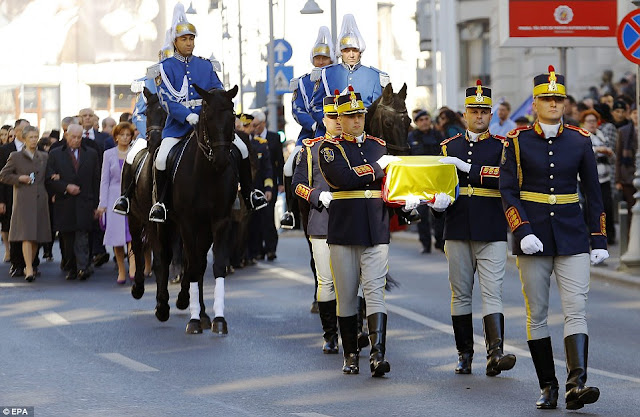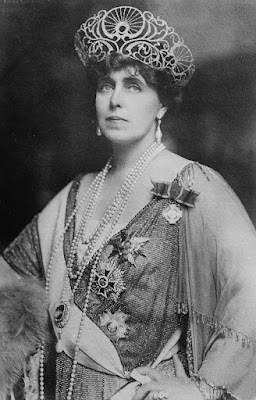The heart of Her Majesty Queen Marie of Romania, the British-born wife of King Ferdinand I, was laid to rest for the final time on November 3 in a ceremony that evoked memories of the deposed monarchy's pageantry and pomp.
Prior to Queen Marie's death in 1938, she stipulated that her heart should be interred in the chapel of the Pelisor Castle, her favorite residence. However, the queen's wishes could not be fulfilled after Pelisor and its surrounding regions were annexed to Bulgaria in 1940. Her heart was then kept at another of her homes, Bran Castle (which today is popularly advertised to tourists as "Dracula's Castle"), until the communist regime which took over in 1947 seized Bran and moved the heart to the National History Museum in Bucharest.
Queen Marie's grandson, King Michael of Romania, who was deposed in 1947 but has since returned to live part-time in Romania and is the head of the deposed royal house, announced his intentions to fulfill his grandmother's wishes by returning her heart to its final resting place at Pelisor.
The ceremony included a formal removal of the heart from the Natural History Museum by Romanian soldiers in the presence of HRH Princess Margareta of Romania, King Michael's eldest daughter and Queen Marie's great-granddaughter, who was accompanied by her husband, HRH Prince Radu, and her youngest sister, HRH Princess Maria. The casket containing the heart was draped in the Romanian and British flags, and both the national anthems of Romania and the United Kingdom were played. A procession took place through the streets of Bucharest before the heart was loaded into a car and driven to Pelisor Castle, 74 miles to the north.
Queen Marie was a granddaughter of the British Queen Victoria. She was born in Kent, England, the daughter of Queen Victoria's second son, Prince Alfred, and Grand Duchess Marie of Russia, daughter of Tsar Alexander II. She married the German-born Crown Prince Ferdinand of Romania in 1893, and became queen consort with her husband's accession in 1914. As Queen of Romania, she was an enormously popular and beloved figure. She was a symbol of national unity and strength during World War I, and she arrived at the Paris Peace Conference in 1918 as a representative of Romanian interests. When it was suggested that she go to Paris after the Romanian prime minister failed to obtain concessions for his country, the queen boldly declared "Romania needs a face, and I will be that face." Her great ability to charm the delegates and to stand up for Romania has been credited with the creation of the Greater Romania after World War I, in which Romania gained a significant amount of territory and became a formidable power in southern Europe. Her flamboyant wardrobe and outspoken nature made her an intriguing and exotic figure. A 1926 visit to the United States garnered enormous media attention and attracted thousands of Americans into the streets of New York to catch a glimpse of her. She was also a published author, having written numerous works including two volumes of her autobiography.
 |
| A casket containing the heart of Queen Marie of Romania is borne through the streets of Bucharest by soldiers. Courtesy of the Daily Mail. |
Prior to Queen Marie's death in 1938, she stipulated that her heart should be interred in the chapel of the Pelisor Castle, her favorite residence. However, the queen's wishes could not be fulfilled after Pelisor and its surrounding regions were annexed to Bulgaria in 1940. Her heart was then kept at another of her homes, Bran Castle (which today is popularly advertised to tourists as "Dracula's Castle"), until the communist regime which took over in 1947 seized Bran and moved the heart to the National History Museum in Bucharest.
Queen Marie's grandson, King Michael of Romania, who was deposed in 1947 but has since returned to live part-time in Romania and is the head of the deposed royal house, announced his intentions to fulfill his grandmother's wishes by returning her heart to its final resting place at Pelisor.
The ceremony included a formal removal of the heart from the Natural History Museum by Romanian soldiers in the presence of HRH Princess Margareta of Romania, King Michael's eldest daughter and Queen Marie's great-granddaughter, who was accompanied by her husband, HRH Prince Radu, and her youngest sister, HRH Princess Maria. The casket containing the heart was draped in the Romanian and British flags, and both the national anthems of Romania and the United Kingdom were played. A procession took place through the streets of Bucharest before the heart was loaded into a car and driven to Pelisor Castle, 74 miles to the north.
 |
| Queen Marie of Romania. Born Princess Marie of Edinburgh, she was a granddaughter of Queen Victoria of the United Kingdom. |

Comments
Post a Comment